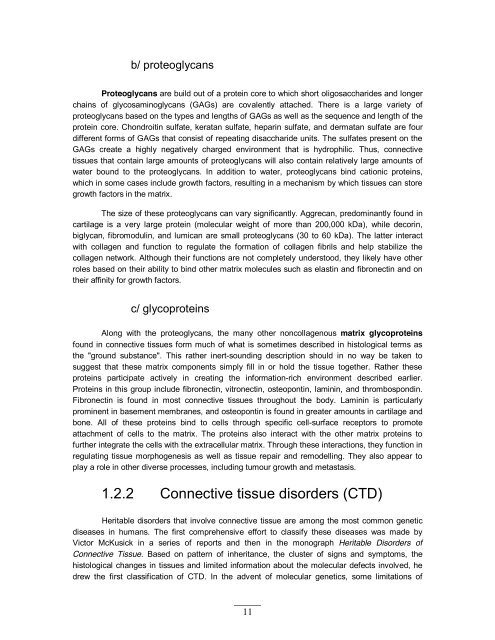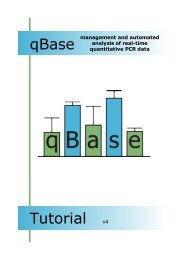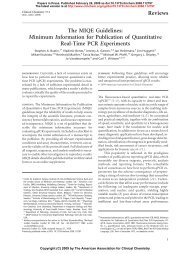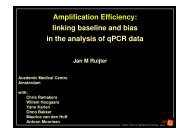This thesis is dedicated to my grandparents
This thesis is dedicated to my grandparents
This thesis is dedicated to my grandparents
Create successful ePaper yourself
Turn your PDF publications into a flip-book with our unique Google optimized e-Paper software.
proteoglycans<br />
Proteoglycans are build out of a protein core <strong>to</strong> which short oligosaccharides and longer<br />
chains of glycosaminoglycans (GAGs) are covalently attached. There <strong>is</strong> a large variety of<br />
proteoglycans based on the types and lengths of GAGs as well as the sequence and length of the<br />
protein core. Chondroitin sulfate, keratan sulfate, heparin sulfate, and dermatan sulfate are four<br />
different forms of GAGs that cons<strong>is</strong>t of repeating d<strong>is</strong>accharide units. The sulfates present on the<br />
GAGs create a highly negatively charged environment that <strong>is</strong> hydrophilic. Thus, connective<br />
t<strong>is</strong>sues that contain large amounts of proteoglycans will also contain relatively large amounts of<br />
water bound <strong>to</strong> the proteoglycans. In addition <strong>to</strong> water, proteoglycans bind cationic proteins,<br />
which in some cases include growth fac<strong>to</strong>rs, resulting in a mechan<strong>is</strong>m by which t<strong>is</strong>sues can s<strong>to</strong>re<br />
growth fac<strong>to</strong>rs in the matrix.<br />
The size of these proteoglycans can vary significantly. Aggrecan, predominantly found in<br />
cartilage <strong>is</strong> a very large protein (molecular weight of more than 200,000 kDa), while decorin,<br />
biglycan, fibromodulin, and lumican are small proteoglycans (30 <strong>to</strong> 60 kDa). The latter interact<br />
with collagen and function <strong>to</strong> regulate the formation of collagen fibrils and help stabilize the<br />
collagen network. Although their functions are not completely unders<strong>to</strong>od, they likely have other<br />
roles based on their ability <strong>to</strong> bind other matrix molecules such as elastin and fibronectin and on<br />
their affinity for growth fac<strong>to</strong>rs.<br />
c/ glycoproteins<br />
Along with the proteoglycans, the many other noncollagenous matrix glycoproteins<br />
found in connective t<strong>is</strong>sues form much of what <strong>is</strong> sometimes described in h<strong>is</strong><strong>to</strong>logical terms as<br />
the "ground substance". <strong>Th<strong>is</strong></strong> rather inert-sounding description should in no way be taken <strong>to</strong><br />
suggest that these matrix components simply fill in or hold the t<strong>is</strong>sue <strong>to</strong>gether. Rather these<br />
proteins participate actively in creating the information-rich environment described earlier.<br />
Proteins in th<strong>is</strong> group include fibronectin, vitronectin, osteopontin, laminin, and thrombospondin.<br />
Fibronectin <strong>is</strong> found in most connective t<strong>is</strong>sues throughout the body. Laminin <strong>is</strong> particularly<br />
prominent in basement membranes, and osteopontin <strong>is</strong> found in greater amounts in cartilage and<br />
bone. All of these proteins bind <strong>to</strong> cells through specific cell-surface recep<strong>to</strong>rs <strong>to</strong> promote<br />
attachment of cells <strong>to</strong> the matrix. The proteins also interact with the other matrix proteins <strong>to</strong><br />
further integrate the cells with the extracellular matrix. Through these interactions, they function in<br />
regulating t<strong>is</strong>sue morphogenes<strong>is</strong> as well as t<strong>is</strong>sue repair and remodelling. They also appear <strong>to</strong><br />
play a role in other diverse processes, including tumour growth and metastas<strong>is</strong>.<br />
1.2.2 Connective t<strong>is</strong>sue d<strong>is</strong>orders (CTD)<br />
Heritable d<strong>is</strong>orders that involve connective t<strong>is</strong>sue are among the most common genetic<br />
d<strong>is</strong>eases in humans. The first comprehensive effort <strong>to</strong> classify these d<strong>is</strong>eases was made by<br />
Vic<strong>to</strong>r McKusick in a series of reports and then in the monograph Heritable D<strong>is</strong>orders of<br />
Connective T<strong>is</strong>sue. Based on pattern of inheritance, the cluster of signs and symp<strong>to</strong>ms, the<br />
h<strong>is</strong><strong>to</strong>logical changes in t<strong>is</strong>sues and limited information about the molecular defects involved, he<br />
drew the first classification of CTD. In the advent of molecular genetics, some limitations of<br />
11





